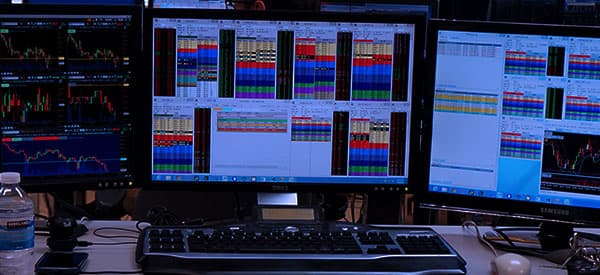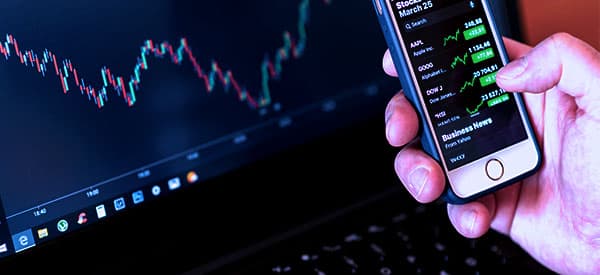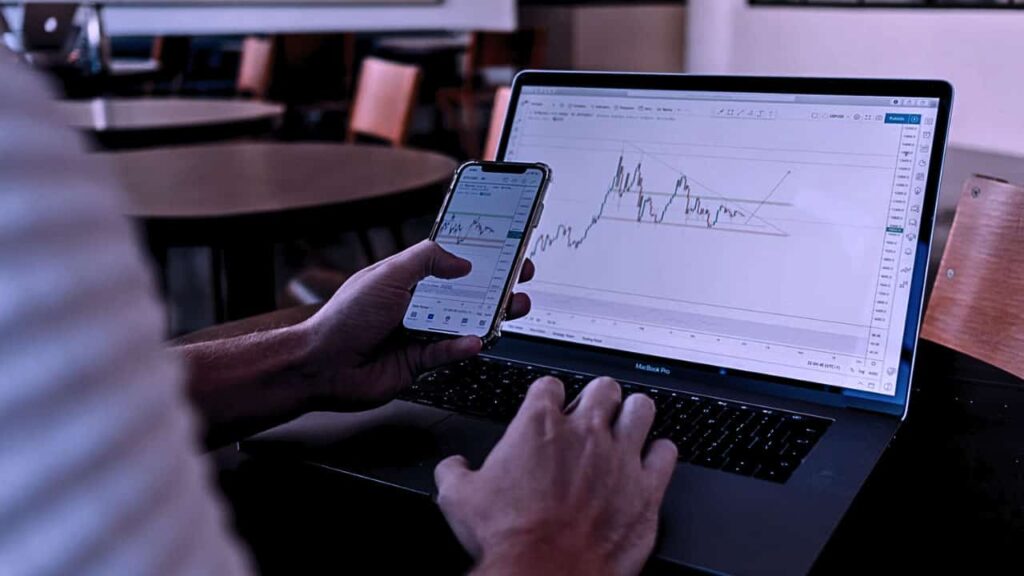Discussions about the current era of mobile devices usually draw a line to 2007, when Steve Jobs introduced the iPhone as a revolutionary phone/iPod/internet communicator.
Of course, before 2007, there were devices that allowed you to take phone calls, listen to music, answer emails, and browse the internet, but they weren’t easy to use.
Today, mobile technology has transformed society in such a way that even running an entire business from your phone is possible.
When it comes to stock trading and investing, mobile apps give amateur and professional traders a convenient way to monitor the market. Contrast this with the proprietary computer terminals and network connections that traders have relied on since the 1970s.
Seems like the mobile device must be the obvious choice if you’re new to short-term trading and anxious to make a career of it. Wouldn’t convenience lead to more trades and better trades? Not exactly—desktop trading’s power has a lot to offer.
It really comes down to recognizing each’s strengths and weaknesses. Once you understand those factors, you can make an informed choice.
In this article, we’ll examine how desktop (including laptop) trading and mobile trading can support short-term trading careers. The most important thing is to match the right tool with the job.
Table of Contents
Desktop Trading

As personal computers and high-speed internet have proliferated, the possibility of trading global markets has spread with them.
While proprietary computer terminals such as the Bloomberg Terminal have been the dominant choice of many firms and professional traders, there are plenty of additional options for short-term traders who want direct market access.
While the term “desktop” is often used to refer to a stationary computer setup, it has expanded to include laptop computers as well. Now, when we talk about “desktop,” it’s mostly to contrast with mobile computing on smartphones and tablets.
Specialized hardware and software are indispensable to the work of a professional short-term trader.
In a nutshell, desktop trading gives traders the tools, power, and space to develop precise trading workflows and execute complex trades with a few clicks. But although desktop trading is state-of-the-art for short-term traders, there are a few limitations.
Pro #1: Powerful Performance
Even though processing chips work on a nanoscale, the physical requirements of computer hardware mean that having more physical space allows greater performance.
Stationary desktop computers can be modified with the fastest central and graphics processing units, additional RAM, and hard drives.
Armed with the best hardware, you can use complex trading software to its fullest capacity. Using tech from proprietary trading firms such as Real Trading, short-term traders can execute trades and even run trading simulations in real-time.
Pro #2: Multiple Monitors
Because short-term trading is fast-paced and dynamic, professional traders use a lot of screen real estate to display charts, analyze data, read global news, check social media, and watch multiple assets at once.
Short-term traders are adept at making split-second decisions. Minimizing and maximizing windows to find the right view is inefficient and leads to trading mistakes.
Conversely, large monitors allow you to look at charts in high fidelity and optimize the layout of the application windows.
Pro #3: Comprehensive Tools
Thanks to the high-end computer performance of desktop trading setups, short-term traders can access the most advanced tools for charting, analysis, and market research.
Sometimes, traders create customized workflows that include streaming news footage, communication with their trading buddies, and bespoke software tools they’ve coded themselves.
Desktop trading setups aren’t unlimited in their capabilities, but they represent the very best hardware available.
Pro #4: Stability
Desktop trading terminals don’t have high-speed internet connectivity—instead, wired ethernet connections ensure traders have the most robust connection to stay synced with the market and receive real-time data.
Long-term investors aren’t nearly as reliant on moment-by-moment market visibility. Short-term traders make and lose money based on rapid fluctuations. They need uninterrupted internet access to stay on top of any market movement. Wired internet connections are the best way to do this.
Con #1: Poor Mobility
Although it’s possible to pack up your monitors, CPU tower, keyboard, mouse, and speakers and move them, it’s too troublesome to do more than necessary.
One solution is buying a high-powered laptop, which will still limit the amount of screen real estate. Laptop-based trading also requires a strong wifi connection, which isn’t universally available when traveling.
Con #2: Setup and Space
A dedicated space for your desktop terminal isn’t a viable option for anyone sharing small living quarters or traveling frequently.
To stay informed about current events and critical market news, you need multiple monitors and maybe even large-screen TVs or peripherals.
A private office or quiet, spare bedroom is ideal, but not at everyone’s disposal. Desktop trading demands laser focus and minimal distractions if you’re going to succeed.
Con #3: Learning Curve
Desktop trading is a skill that takes study and practice to master. The fundamental principles and advanced techniques are mastered through constant trading, reflection, simulation, and optimization.
Short-term traders take in a fire-hose of information without allowing it to overwhelm their executive function. Many people fantasize about the life and career of short-term traders, but they struggle to keep up with the day-to-day reality of short-term trading.
Mobile Trading

In a way, mobile trading originated in the days of telegraphs and phone calls to brokers who trade on your behalf.
Today it looks like opening a trading app from companies such as Robinhood, Thinkorswim, and E*Trade. Many of these apps are only available in the United States, but other options exist.
Mobile trading is convenient and accessible to nearly anyone with a smartphone. That said, it has some serious drawbacks for professionals.
Pro #1: Portability
Smartphones put incredible power and connectivity in the palm of your hand. If you’re riding a bus and want to check a stock price, you can do it in one or two taps. That level of visibility without being on a trading floor was unheard of until the early 2010s.
Mobile trading is a gift if you’re a trader who likes to travel—you can even execute trades from your phone. However, this type of trading is better suited to long-term traders or investors, because it’s easier to track bigger market shifts than it is to track small fluctuations favored by short-term traders.
Pro #2: Convenience
When you trade from a mobile device, you don’t need to walk to your desk or wait for your computer to boot up. The app opens in seconds, and you can quickly access the assets that matter to you.
You don’t have to feel stuck in front of a computer or constrained by rigid trading hours. Mobile trading is as convenient as it gets.
Pro #3: Push Notifications
Mobile trading apps can send you alerts for price changes or other triggers that you set up. That means you can pay attention to other tasks while the app watches the stock for you.
Push notifications are fast, but not as fast as watching the market in real-time. This delay is known as “slippage” in the trading world and can have a negative impact on short-term trading strategies.
Con #1: Limited Screen Size
Smartphone screens may have grown to nearly twice the size of the original iPhone, but they’re tiny compared to most computer monitors. That means you only have room to view one chart or document at a time in reduced fidelity.
Professional short-term traders multitask frequently, and mobile apps simply don’t allow fast switching between apps and user interfaces.

Con #2: Potential Connectivity Issues
Signal strength determines how successful your mobile trading strategy is. Cellular coverage has dramatically improved and is reinforced by public and private wifi networks. That means your connection should be good enough most of the time.
However, it’s not guaranteed—especially in a crowd or between signal towers. You can’t control when a lost connection happens, which means that your trade orders risk dropping without notice.
Con #3: Battery Life
A desktop trading terminal has a constant power supply (barring a power outage).
A mobile device has a battery that depletes and has to be charged. Just imagine how you’d feel if you were waiting for a breakout only to have your phone turn off.
Trading apps are data and processor-intensive. They use battery power faster than other apps, meaning you’ll need to find a place to charge or carry battery backups.
Con #4: Simplified Tools
Smartphones and trading apps may be remarkably powerful compared to their small form factor, but there’s no way around the reduced functionality. Mobile trading apps limit the features and functions to stay in step with the hardware’s storage and performance limitations.
Fewer functions won’t be a big deal for new traders, but anyone who has learned on a desktop trading platform will experience far more pain and frustration using a mobile app.
Recommendations for New Short-Term Traders
Nowadays, everybody has a mobile device, so learning to trade on mobile must be an easier option for most people. Except that’s not true, especially for anyone looking to build a long-term career as a short-term trader.
At Real Trading, our people have decades of experience trading and teaching others to trade. We’ve seen lots of technology changes and trading fads. Here’s what we recommend to new traders.
Start With Desktop
There’s no two ways about it. Learning the skill of short-term trading takes dedication and the right tools.
The best training programs for short-term traders include courses on specific topics and lots of time in a trading simulator. Mastering these fundamentals is much easier on a desktop trading setup, whether a proprietary terminal or a cloud-based platform.
The key is finding a platform with real-time, direct market access and full-featured tools for analysis.
Use Mobile for Monitoring
The best use case for mobile trading apps is monitoring prices on the go. If you happen to see surprise swings or trend continuations, you should be able to take the basic actions necessary to capitalize.
Mobile trading apps can give you the freedom to leave your desk more often, which everybody enjoys. You just don’t want to confuse visibility with capability: mobile apps excel at the former and struggle with the latter. Monitor on mobile, and take exhaustive action on desktop.
Skills Make the Trader
The fanciest technology set up in the world will not make you a better short-term trader.
Trading success comes when you combine excellence in the fundamentals with quick and disciplined trading methodology. Technology is just a gateway to opportunity.
Real Trading has spent years refining our training program and technology platform. Our mission is to find the most talented people and help them build profitable short-term trading careers.
Real Trading offers the best resources and global community for short-term trading. If you’re ready to explore a career as a professional trader, you can start today.





